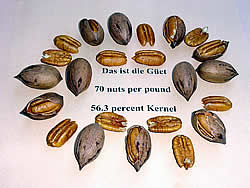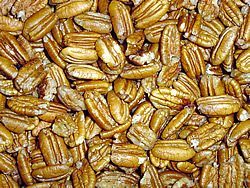Pecan Nomenclature
Larry Stein
This time of year, when growers are contemplating how and
when to sell their  native
crop, it is interesting to note how the "travel" for
pecans has changed in the short 124-history of commercial pecan
growing. Of course, "native growing" has been around
a lot longer than that. We guess the former Indian tribes who
frequented the river bottoms would be our best judges of that
fact.
native
crop, it is interesting to note how the "travel" for
pecans has changed in the short 124-history of commercial pecan
growing. Of course, "native growing" has been around
a lot longer than that. We guess the former Indian tribes who
frequented the river bottoms would be our best judges of that
fact.
Pecans were first moved to markets maybe 75 miles from their
point of origin, in an ox-drawn wagons at a mere two-to three-
miles per hour. San Antonio was the destination of many such
pecans as it was a prime shelling center. Within a century,
pecans went to the moon, a trip of some 240,000 miles on Apollo
13 at speeds of close to 25,00 mph. Today, pecans are bought
and sold instantly on the internet and exported to many parts
of the world. Years ago, only natives were shelled and standard
varieties were sold as in-shell pecans. Today, over 90% of the
pecans are sold to the consumer as some sort of shelled pecans-halves,
pieces or meal. Only time will; tell where the next 50 years
as in-shell pecans. Today, I want to shed light on the question
of just what constitutes a native, seedlind and improved pecan,
as well as address the question of which pecan tastes the best.
A native pecan is defined as one hybridized under natural
conditions. As far as can be ascertained from the history of
the tree's origins and from the appearance of the nut, there
was no named variety heat served as either parent. Realize that
native pecans are for the most part average in size, but they
can easily be as big. Just because the nut is large does not
mean it is not a native. In fact, I can assure that you would
be surprised at the size of some native pecans. For the most
part, natives have a hard shell much like the Stuart variety,
but many times even harder. On a 40,000-pound lot, typical shell-out
is 41- to 42-percent kernel, but many natives are soft shelled
and easily shell at 56- to 60-perent kernel. Kernel color is
often golden which most associated with the high oil content.,
buy I have seen them as white as Cheyenne. The genetic diversity
of the native pecan bottoms is simply incredible. Today, if
a survey were to be given to pecan consumers, I would venture
to say that most would pick natives as having the best taste.
However, in some taste tests, this has not always proven to
be true. This is because all native trees are genetically different.
No two are the same, so if you find a really good one, you would
want to clonally propagate it is to increase this particular
quality.
Seedling pecans are ones originating from nuts planted by
man or beast where only one parent is known. Sometimes neither
parent is known, and the nut could be from a native or improved
cultivar. Usually when only one parent is known, it is the female
or better said the parent that produced the nut. Typical, well-known
seedling pecans include Mahan, Schley, Maramec and Podsednik.
Maramec originated from a Mahan pecan planted in Oklahoma and
Podesdnik from a Success type of pecan planted in Arlington,
Texas. Realize there are thousands more and most fold want to
know what they have. But, all one can say is that they had a
"seedling Pecan". Their tree originated from a nut
of Choctaw, Success, Western, etc. They range in size from "huge"
to very small. Some shell well and others have so much fuzz
it is hard to know if you have kernel or shell. Taste varies
from good to okay.
Lastly we have pedigreed cultivars in which we are confident
we know both parents. The USDA pecan breeding program had done
a remarkable job of improving cultivars. Some of their greatest
success stories include Wichita and Cheyenne. Very large pecans
have been developed and others not so big. Size appeared to
be critical early on in the breeding program as Choctaw, Mohawk,
Kiowa were released, but today, size is not as critical. More
emphasis has been placed on nut quality, disease and insect
resistance, and continued yield ability. Two recently released
cultivars that look extremely promising include Hopi and Nacono.
Of all the named cultivars to date, I think the one hat has
the best eating quality is Sioux. Sioux is a Schley by a Carmichael
cross. Of course, Schley is a very high quality seedling and
it was crossed with a high quality native pecan-Carmichael.
Hence, there is not real secret why it tastes so good. Still,
realize taste is a very subjective thing-typically, 50 percent
will think something is awesome and the other half would not
put it in their mouths. Also realize that nut quality varies
from year to year, based on grown conditions. Nuts on over-cropped
trees are not nearly as good as nuts from trees with the proper
load. Well-managed trees are not nearly as good as nuts from
trees with the proper load. Well-managed trees often have better
pecans than trees that receive little care. However, stress
is the key. As long as the trees are not in severe stress, the
nuts should be good. Many years, non-managed trees will have
favorable growing conditions and the nut quality will be okay.
Other years, we can do everything right and still end up with
poor quality. So, in reality, taste is very subjective and depends
a lot on the growing conditions that produced the crop.
Today, we are blessed with good cultivars for most situations,
be the homeowner or large-scale commercial grower. True we don't
have perfect varieties, but some are really close. But realize,
too, that this was not always the case. Our early pecan enthusiast
had to find their own "varieties" in their native
pecan bottoms.
So the emphasis of our forefathers was to find native trees
that consistently produced a good crop from year to year, had
a nice size pecan because all were picked by hand, shelled well,
and tasted good-not much different than our breeding program
today. Make no mistakes about it as well. Many such native pecans
were found and propagated by the family, landowner, or the one
who discovered the nut. One such pecan is the Prilop that comes
out of Lavaca County and is currently being propagated in Texas.
 My
grandfather had about 50 acres of native pecans to work. Of
course, trees arranged in size from very large to seedlings.
The drought of the 1950's took its toll on the large trees,
but this is a normal weather calamity in the grand scheme of
things and even though it is hard to lose big trees, this makes
room for different genetic material to make their impact known.
Over the years my family identified trees that they would harvest
for their own use because of the outstanding qualities of the
tree and nut. Today, we propagate one which they considered
to be their very best-i.e. Das ist die Guet!, meaning this is
the "good!" in the Alsatian language. Three such Guets
were identified, but only this one was propagated and today
it is simply known as the "Guet". This pecan shells
in perfect halves at 53 to 56 percent kernel; has very wide
dorsal (upper) grooves and little if any ventral grooves; ranges
in size from 65 to 70 nuts per pound and has an awesome flavor.
One drawback to the nut is that it turns dark fairly quickly,
presumably from the high oil content! However, other trees were
named based on the family who purchased the pecans, because
they like that particular nut. In our pecan bottom, there were
several such trees including the die Stolte Bauem (the Stolte
tree), die Brymer bauem (the Brymer tree), and die Briet (the
wide). Every year, these trees were harvested and kept separate
for these individual families or special friends. A few other
well known trees on the "other" side of the river
(which happens to be the side of the river my mom is from),
were die Saloon (wirtzhus) bauem. Yes, you guessed it. That
is where the beer keg sat when there was cause for celebration
and die renne bauem-where the wagering for the weekend horse
race often took place.
My
grandfather had about 50 acres of native pecans to work. Of
course, trees arranged in size from very large to seedlings.
The drought of the 1950's took its toll on the large trees,
but this is a normal weather calamity in the grand scheme of
things and even though it is hard to lose big trees, this makes
room for different genetic material to make their impact known.
Over the years my family identified trees that they would harvest
for their own use because of the outstanding qualities of the
tree and nut. Today, we propagate one which they considered
to be their very best-i.e. Das ist die Guet!, meaning this is
the "good!" in the Alsatian language. Three such Guets
were identified, but only this one was propagated and today
it is simply known as the "Guet". This pecan shells
in perfect halves at 53 to 56 percent kernel; has very wide
dorsal (upper) grooves and little if any ventral grooves; ranges
in size from 65 to 70 nuts per pound and has an awesome flavor.
One drawback to the nut is that it turns dark fairly quickly,
presumably from the high oil content! However, other trees were
named based on the family who purchased the pecans, because
they like that particular nut. In our pecan bottom, there were
several such trees including the die Stolte Bauem (the Stolte
tree), die Brymer bauem (the Brymer tree), and die Briet (the
wide). Every year, these trees were harvested and kept separate
for these individual families or special friends. A few other
well known trees on the "other" side of the river
(which happens to be the side of the river my mom is from),
were die Saloon (wirtzhus) bauem. Yes, you guessed it. That
is where the beer keg sat when there was cause for celebration
and die renne bauem-where the wagering for the weekend horse
race often took place.
Pecans and pecan history are unique to all of their native
sites. I am sure there are countless stories that could be told.
Here is hoping their value and stories will be long remembered
in future years.






